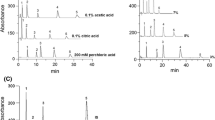Abstract
Regional levels of cerebral inositol-1-phosphate (Ins1P), an intermediate in phosphoinositide (PI) cycle, were readily detected with a new gas chromatographic (GC) method. GC analysis of trimethylsilyated Ins1P and myo-inositol-2-phosphate with a fused silica capillary SE-30 column and flame ionization detection was linear at picomolar range (pmol/μl) with a sensitivity to a level of 2 pmol. Also, inositol monophosphates and glucose-6-phosphate are separated in unstimulated brain tissue. The mean recovery of the method is 98±5.2%. Ins 1P levels were higher in frontal than in caudal regions in control brains. Lithium treatment increased the levels of Ins1P throughout the brain but mostly in frontal brain regions and in the hippocampus. The present GC assay to measure the accumulation of Ins1P, an index for the activity of PI signalling, may be suitable for exploring regional differences in cerebral receptor-coupled PI signalling in vivo.
Similar content being viewed by others
References
Michell, R. H., and Kirk, C. 1986. G-protein control of in-ositol phosphate hydrolysis. Nature (London) 323:112–113.
Putney, J. W., Jr. 1987. Formation and actions of calciummobilizing messenger, inositol 1,4,5-trisphosphate. Am. J. Physiol. 252, (Gastrointest. Liver Physiol. 15):G149-G157.
Berridge, M. J., and Irvine, R. F. 1984. Inositol trisphosphate, a novel second messenger in cellular signal transduction. Nature 312:315–321.
Nishizuka, Y. 1986. Studies and perspectives of protein kinase C. Science 233:305–312.
Hallcher, L. M., and Sherman, W. R. 1980. The effects of lithium ion and other agents on the activity of myo-inositol-1-phosphatase from bovine brain. J. Biol. Chem. 255:10896–10901.
Berridge, M. J., Downes, C. P., and Hanley, M. R. 1982. Lithium amplifies agonist-dependent phosphatidylinositol responses in brain and salivary glands. Biochem. J. 206:587–595.
Berridge, M. J. 1986. Inositol phosphates as second messengers. Pages 25–45,in Putney, J. W. (ed.), Phosphoinositides and receptor mechanisms, Alan R. Liss, Inc., New York.
Irvine, R. F. 1986. The structure, metabolism, and analysis of inositol lipids and inositol phosphates. Pages 89–107,in Putney, J. W. (ed.), Phosphoinositides and receptor mechanisms, Alan R. Liss, Inc., New York.
Allison, J. H., Blisner, M. E., Holland, W. H., Hipps, P. P., and Sherman, W. R. 1976. Increased brain myo-inositol-1-phosphate in lithium-treated rats. Biochem. Biophys. Res. Commun. 71:664–670.
Sherman, W. R., Leavitt, A. L., Honchar, M. P., Hallcher, L. M., and Phillips, B. E. 1981. Evidence that lithium alters phosphoinositide metabolism: Chronic administration elevates primarilyd-myo-inositol-1-phosphate in cerebral cortex of the rat. J. Neurochem. 36:1947–1951.
Sherman, W. R., Munsell, L. Y., Gish, B. G., and Honchar, M. P. 1985. Effect of systemically administered lithium on phosphoinositide metabolism in rat brain, kidney and testis. J. Neurochem. 44:798–807.
Eisenberg, F. 1967.d-Myoinositol as a product of cyclization of glucose 6-phosphate and substrate for a specific phosphatase in rat testis. J. Biol. Chem. 242:1375–1382.
Leavitt, A. L., and Sherman, W. R. 1982. Resolution ofDl-myo-inositol 1-Phosphate and other sugar enantiomers by gas Chromatography. Methods Enzymol. 89:3–9.
Pellegrino, L. J., Pellegrino, A. S., and Cushman, A. J. 1979. A stereotaxic atlas of the rat brain, 2nd ed., Plenum Press, New York.
Harvey, D. I., Horning, M. G. 1973. Characterization of the trimethylsilyl derivatives of sugar phosphates and related compounds by gas chromatography and gas chromatography/mass spectrometry. Chrom. 6419:51–62.
Binder, H., Weber, P. C., and Siess, W. 1985. Separation of inositol phosphates and glycerophosphoinositol phosphates by high performance liquid chromatography. Anal. Biochem. 148:220–227.
Downes, C. P., and Michell, R. H. 1981. The polyphosphoinositide phosphodiesterase of erythrocyte membranes. Biochem. J. 203:169–177.
Batty, I. R., Nahorski, S. R., and Irvine, R. F. 1985. Rapid formation of inositol 1,3,4,5,-tetrakis-phosphate following muscarinic receptor stimulation of rat cerebral cortical slices. Biochem. J. 232:211–215.
Irvine, R. F. 1986. The structure, metabolism, and analysis of inositol lipids and inositol phosphates Pages 87–107,in Putney, J. W. (ed.), Phosphoinositides and receptor mechanisms, Alan R. Liss, Inc., New York.
Van Rooijen, L. A. A., Vadnal, R., Dobard, P. and Bazan, N. G. 1986. Enchanced inositide turnover in brain during bicuculline-induced status epilepticus. Biochem. Biophys. Res. Commun. 136:827–834.
Sherman, W. R., Honchar, M. P., Munsell, L. Y. 1985. Detection of receptor-linked phosphoinositide metabolism in brain of lithium-treated rats. Pages 49–65,in Bleasdale, J. E., Eichberg, J., Hauser, G. (eds), Inositol and Phosphoinositides: Metabolism and regulation, Humana Press, Clifton, New Jersey.
Sherman, W. R., Ackerman, K. E., Berger, R. A., Gish, B. G., and Zinbo, M. 1985. Analysis of inositol mono- and polyphosphates by GC/MS and FAB. Biomed Environ Mass Spectrum. 13:333–341.
Honchar, M. P., Olney, J. W., and Sherman, W. R. 1983. Systemic cholinergic agents induce seizures and brain damage in lithium-treated rats. Science 220:323–325.
Sherman, W. R., Gish, B. G., Honchar, M. P., and Munsell, L. Y., 1986. Studies on the effect of lithium on phosphoinositide metabolism in vivo. Fed. Proc. 45:2639–2646.
Majerus, P. W., Connolly, T. M., Bansal,V. S., Inhorn, R. C., Ross, T. S., and Lips, D. L. 1988. Inositol Phosphates: Synthesis and Degradation. J. Biol. Chem. 263:3051–3054.
Savolainen, K., Nelson, S. R., Samson, F. E., and Pazdernik, 1986. Lithium potentiates soman-induced seizures and modifies alterations in cerebral myo-inositol-1-phosphate levels. Abstract of the Neuroscience Annual Conference, Washington, D.C.
Hirvonen M.-R., Komulainen, H., Lihtamo, H. Paljärvi, L., and Savolainen, K. 1987. Effects of malaoxon on rat brain myo-inositol-1-phosphate levels Abstract of the XXXIII Nordic Meeting of Pharmacology, June 2–5, 1987, Kuopio, Finland.
Savolainen, K., Terry, J. T., Nelson, S. R., Samson, F. E., Pazdernik, 1987. Seizures and cerebral myo-inositol-1-phosphate levels in DFP-treated rats. Abstract of 27th Congress of European Society of Toxicology, September 17–19, 1987, Strasbourg, France.
Author information
Authors and Affiliations
Rights and permissions
About this article
Cite this article
Hirvonen, MR., Lihtamo, H. & Savolainen, K. A gas chromatographic method for the determination of inositol monophosphates in rat brain. Neurochem Res 13, 957–962 (1988). https://doi.org/10.1007/BF00970768
Accepted:
Issue Date:
DOI: https://doi.org/10.1007/BF00970768




